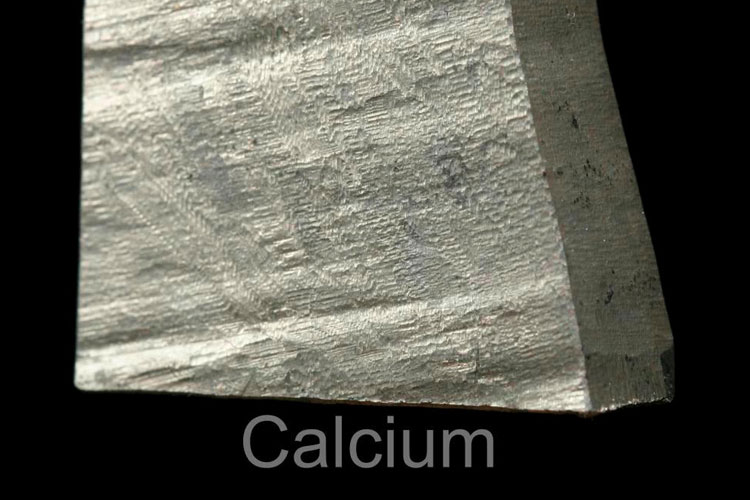What are the Hazards of Calcium?
Calcium is a chemical element with symbol Ca and atomic number 20. Calcium is a soft gray alkaline earth metal, fifth-most-abundant element by mass in the Earth's crust. The ion Ca2+ is also the fifth-most-abundant dissolved ion in seawater by both molarity and mass, after sodium, chloride, magnesium, and sulfate.
Calcium may be used as a reducing agent in the process of metal extraction. Calcium is also used in the production of some metals, as an allying agent. Calcium carbonate is used to make cement and mortar and also in the glass industry. Calcium carbonate is also added to toothpaste and mineral supplements.
Calcium carbide is used to make plastics and to make acetylene gas. Calcium arsenate acts as an insecticide and calcium phosphide can be used as a rodenticide, as well as in fireworks and flares. Calcium phosphate is used in animal feed and fertilizers. Calcium hydroxide solution is used as blackboard chalk and as Plaster of Paris in its hemihydrate form.
Calcium gluconate is used as a food additive. Calcium stearate is used to make wax crayons, cosmetics, plastics and paints.
Inhalation of calcium dust causes irritation of the eyes, nose and respiratory track, which leads to headaches, dizziness and nausea. High levels of calcium can burn the skin, and it can also cause pulmonary edema, a condition in which the lungs are filled up with fluids. Inhaling sulfur may also cause coughing, sneezing or labored breathing.
Calcium is Combustible and is an Explosion Hazard:
When most people think of controlling dust in the workplace, they think of taking steps to avoid inhaling dusts to prevent health problems. However, the accumulation of combustible dusts in the workplace can lead to far greater consequences. As seen in recent years, neglect of housekeeping and improper handling of combustible dusts can lead to property damage, injuries and loss of life.
Fine dust of calcium dispersed in the air is a potential hazard. Dust suspended in air is readily ignited by fumes or static electricity and can cause destructive fires.
The National Fire Protection Association (NFPA) defines a combustible dust as “a combustible particulate solid that presents a fire or deflagration hazard when suspended in air or some other oxidizing medium over a range of concentrations, regardless of particle size or shape.”
In general, combustible particulates having an effective diameter of 420 μm or smaller, as determined by passing through a U.S. No. 40 Standard Sieve, are generally considered to be combustible dusts. However, agglomerates of combustible materials that have lengths that are large compared to their diameter (and will not usually pass through a 420 μm sieve) can still pose a deflagration hazard. Therefore, any particle that has a surface area to volume ratio greater than that of a 420 μm diameter sphere should also be considered a combustible dust. The vast majority of natural and synthetic organic materials, as well as some metals, can form combustible dust. The NFPA’s Industrial Fire Hazards Handbook states, “any industrial process that reduces a combustible material and some normally non-combustible materials to a finely divided state presents a potential for a serious fire or explosion.”
Suggested Industrial Vacuums for Recovery of Toxic & Combustible Dust
PrestiVac HEPAPlus* Vacuums are specifically designed to safely vacuum toxic dusts. Equipped with a Certified Absolute HEPAPlus*filter with an efficiency of 99.995% on 0.2 micron so there is no risk of exposure or contamination for the operator or the environment. These vacuums are tested for absolute filtration. Testing Method: IEST RP-CC034.3. H14. MIL-STD 282 / A.S.T.M. - D2986-91. MPPS method EN 1822.
PrestiVac Explosion Proof/Dust Ignition Protected Vacuums are designed to safely vacuum explosive, flammable, combustible conductive* dusts. Our Explosion Proof/Dust Ignition Protected Vacuums are completely grounded and static dissipating because they are built entirely with non-sparking metals and do not have any painted components so there is no risk of fire or explosion from a spark or static build up. All the electrical components, including the motor and starter are totally enclosed so there is no source of ignition. Our explosion proof vacuum cleaners comply with NFPA 484 guidelines and are an effective tool for good housekeeping practise as per OSHA.
- Dust Ignition Protected Division 2 Vacuums
- Dustless Sanding Vacuums
- Explosion Proof Division 1 Vacuums
- HEPA Vacuums
- Immersion Separator
- Immersion Separator Dustless Sanding Vacuums
Which Industries are at Risk with Calcium?
- Chemicals
- Combustible Dust
- Food Processing
- Metals
- Mining
- Nutraceutical
- Packaging
- Warehouse / Distribution













